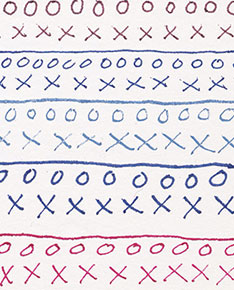

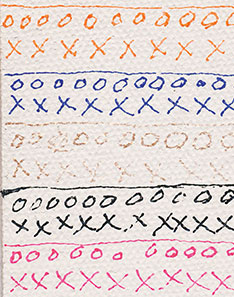
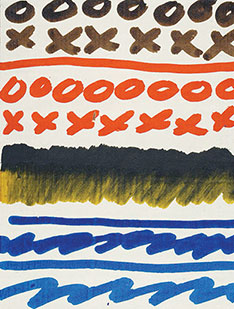

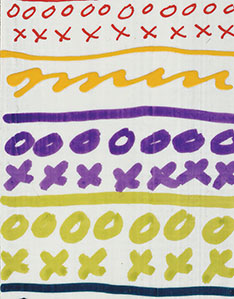
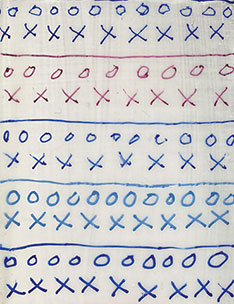
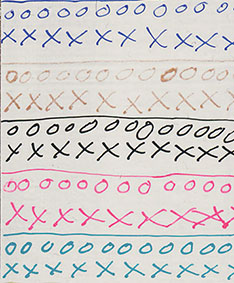

The ease we all feel in picking up a pen and writing something down has facilitated us to translate, transcribe and transform the thoughts in our heads to a tangible surface. While this may work very easily in everyday life, traditional inks can present problems when used within artwork from issues of permanence to compatibility with other materials, to adhesion. The advantages of inks come from hundreds of years of improving the technology of their delivery. Meaning as ubiquitous as the modern pen is, it is a highly evolved system for delivering a dye based fluid system onto paper. All of this makes for a successful tool for transcribing thoughts onto paper, but it is less successful as a permanent artists’ tool. Among the advantages of the new High Flow Acrylic paint is that it allows artists the peace of mind that they are using a product designed for use in art but with the fluidity and ease of use typically reserved only for inks and office grade products.
As is typical around here, we have done a wide series of exercises and tests using these new colors in order to support the many different uses this line will be expected to perform for artists. What I have attempted to create is a list of current best practices and starting points for using the High Flow Acrylic paints within a drawing tool and evaluating the performance color by color, on a range of substrates. For simplicity sake, (not something we are well noted for), I’ve chosen 8 colors to represent the larger full line of 49 colors. Each color represents a particular pigment particle size as this proved to be the most important singular property influencing High Flow’s attributes in different writing implements. The pens, refillable markers and other ink delivery devices were chosen based on what artists use and what is most popular.
When using pigmented paints in pens (quill, technical, ruling, or calligraphic) or markers (daubers, nylon tips or sponge mops), the number one deciding factor in the fineness of line is pigment particle size. “Will that particle, which is size x really fit into a size x nib and continue to flow?†We filled, dipped, wrote, scribbled, hatched and cleaned each color in each pen and marker to understand and highlight the properties of each of our color groupings. Our choice of substrates included typical writing surfaces and a variety of acrylic grounds that offer a range of options and attributes that can be explored with each device and color used. In addition to how the individual pens and markers worked we also looked at how they needed to be cleaned, the ease of cleaning them, and the general maintenance when in use and when stored.
One of the great perks with introducing the High Flow line was being able to add colors that had been otherwise unavailable in our older Airbrush color line. Some of these new additions have the largest pigment particle size within the line. These include all the Iridescent colors, Fluorescent colors and some of the inorganic mineral pigments. While these colors did perform well in most pens and markers, they also required greater maintenance while working.
Since High Flow Acrylics are paint and not simply another ink, we found it imperative to evaluate substrates well beyond the typical paper surfaces. In addition to cold and hot pressed watercolor paper we tested frosted polyester, raw and gessoed canvas, Black Gesso, Sandable Hard Gesso, Acrylic Ground for Pastels, Molding Paste, Absorbent Ground, Regular Gel (Gloss) and a number of different paints and pastes. Common sense often dictates what pen or marker should be used on what particular surface. For example, using a crow quill pen on Fiber Paste does not showcase the delicate smooth line created by the crow quill but instead causes the pen to skip over the low parts of the hard Fiber Paste texture thus dictating the movement of the pen. The more textured, grittier, bumpier substrates do not offer surfaces compatible with pens that deliver thin, delicate lines but on the other hand they work great with markers. Overall, smoother surfaces provided better grounds for thinner, more delicate lines and while it is possible to use technical and crow quill pens on the rougher surfaces, doing so required slower and more deliberate movements.
Paper: High Flow Acrylics function much like a standard ink on paper. On hot pressed watercolor paper the lines were crisp and the marks were even. Cold pressed watercolor paper, due to increased texture and varied absorbency, made for lines with slightly fuzzier edges and the paint did not flow as well. Overall, due to the absorbent nature of most papers, the High Flow absorbed well into the paper, making less of a paint film sitting atop the surface and thus exhibited little to no sheen.
Frosted Polyester Film: Similar to cold pressed watercolor paper this surface was very smooth and created crisp, even flowing lines. The surface offers no drag to the stylus and creates no skips or chattering when written upon. There is no absorbency to this surface so the High Flow sits on top, showing its film, sheen and profile.
Canvas; Raw And Gessoed: On raw canvas it was difficult to get an even, consistent line from technical pens and crow quill pens. Gessoed canvas provided a better surface on which to write. The delicate marks made were crisp due to the balanced absorbency of the gesso. The thinness of the paint on the gessoed surface showcased the canvas texture by concentrating in the recesses of the weave.
Panel With Gesso, Sandable Hard Gesso, Black Gesso: Both Gesso and Sandable Hard Gesso provided great surfaces to write on and worked similarly in the acceptance of the paint. They both exhibited similar levels of absorbency in terms of how much of a sheen or profile the paint had on the surface. Black Gesso worked similarly although due to its color, should be reserved for lighter and brighter paint choices as the darker paints only show sheen when viewed at an angle. Black Gesso strongly showcased Iridescent and Fluorescent colors much better than white surfaces allowing the paint to pop out, especially with more delicate, thin marks.
Absorbent Ground: This was a more challenging surface to write on. The thin metal styluses scratched across the surface showing its delicate dry nature and while the mark was successful, the experience was less so. When the refillable markers were used, there were fuzzy edges due to the increased absorbency of the ground. Much like watercolor paper, there was no profile or sheen to the paint as it had soaked into the ground.
Molding Paste: Proving to be one of the best acrylic surfaces to write on, it worked similarly to the frosted polyester film in regards to smoothness and experience but with some absorbency. The quality of the marks made was very good with a balanced level of absorbency, showing some sheen and profile to the marks made. The marks did not have the fuzzy edges seen on the more absorbent surfaces but rather, had a softness to the edges.
Acrylic Ground For Pastels Its sandy texture added for some resistance when writing upon with the finer styluses and an uneven absorbency caused the marks made by the markers and other tools to bleed, making for a less controlled mark.
Regular Gel (Gloss): This surface held the marks beautifully; producing clean crisp lines with the finer marks made and with lessened absorbency, did not bleed with the markers. The challenge with this surface was the softness and flexibility and how that affected application. The markers went on fine but the thinner needle-like metal styluses easily stabbed at the surface with the slightest amount of pressure. The sheen and profile of the mark were evident.
Painted Surfaces: The marks made on painted surfaces depended largely on the nature of the paint and its application. Thin paint films on harder surfaces worked better with the finer styluses while thicker, more flexible ones were easily stabbed by the pen tip. Markers had no problem going onto dried paint films and overall, produced marks that were anticipated.
The pens that were chosen for this testing represent a very small percentage of what is available. The potential of what could conceivably work with High Flow Acrylics in regards to pens and markers is huge and while we tested some of the more popular options and did not have problems, we cannot guarantee that the mechanisms of some pens will not be damaged with the use of acrylics in them. For this reason we recommend reading any literature that accompanies the pen or marker and contacting the manufacturer regarding how long to leave the pen filled and how to clean it. In some cases it was found that the solvent based cleaners recommended to clean the pens were not necessary since High Flow can be cleaned up with water. Certain pens, especially fountain pens that have elaborate channels and mechanisms can be much harder to clean and may work for a few times but can quickly become clogged due to the fact that the paint will pool and dry inside the pen in areas that are inaccessible. It is therefore not advisable to use your expensive fountain pen with this permanent acrylic paint.
Technical Pens: The smallest size pen that all of the High Flow Acrylic colors worked in all of the time was .5 mm. This means that there were no issues in .5 mm and larger. Some of the smaller sized technical pens were able to accommodate all of the colors but not with the consistency desired. The smallest size we tested, .13 mm, did not allow for any color to come through the pen. The next largest sizes (.25 mm, .30 mm and .35 mm) worked for all of the colors but when the Fluorescent and Iridescent colors were used, the tip needed to be wetted occasionally and the pens needed to be cleaned after each use. Even though this size orifice tended to be fussier, the amazing thin line can be quite exquisite and something to investigate. We were able to leave the pens filled for several weeks without cleaning, but would recommend that they be cleaned after each use or every few days as leaving the acrylic in the pen any longer could ruin the mechanism.
Crow Quill Pens: Crow quill pens worked beautifully. The paints with the larger pigment particle size demanded more dipping and more cleaning but due to the design of the nib, this was a very easy process that included dipping the nib into water and wiping it with a soft cloth.
Markers: Marker blanks come in a variety of sizes with a variety of tips and can be filled with High Flow. Be sure that the marker blank comes with a bearing or barundum to help agitate the paint when shaking. Overall the Iridescent colors worked in the markers and created a consistent mark for about one week before requiring increased priming of the tip. The Fluorescent colors worked in the markers for just under a month. With the exception of Titanium White and Titan Buff, which required more priming after several weeks, the rest of the colors worked beautifully for the next several months with a few exceptions. The heavier mineral pigments, including the Transparent Red Iron Oxide, Yellow Oxide, Raw Umber, Ultramarine Blue and Raw Sienna needed increased priming and shaking prior to use. After roughly 3-4 months most of the markers still work and work well although they do require increased shaking, priming of the felt tip (depressing prior to writing) and in some cases a slight wetting of the felt tip (quick dip in water). It is highly recommended to change the felt tip when needed and to purchase marker blanks that allow for tip replacement.
Styluses: With many of the styluses that we tested we saw some consistencies worth noting. Speed of motion when writing or drawing is essential. Slow and steady produces the cleanest and most consistent quality line. Often moving too quickly across the surface will cause skipping or chattering. Maintenance of the writing implement is essential to the quality of the mark made but also to the future functionality of that stylus.
High Flow Acrylics offer a lot of opportunity previously unavailable with traditional inks or thicker acrylic paints. We have only skimmed the surface in regards to the potential of where artists will take these paints and while we encourage pushing the limits, we also recommend testing where those boundaries lie so the control is in hand of the user as opposed to the limitations of the tools.
About Amy McKinnon
View all posts by Amy McKinnon -->Subscribe
Subscribe to the newsletter today!
No related Post
